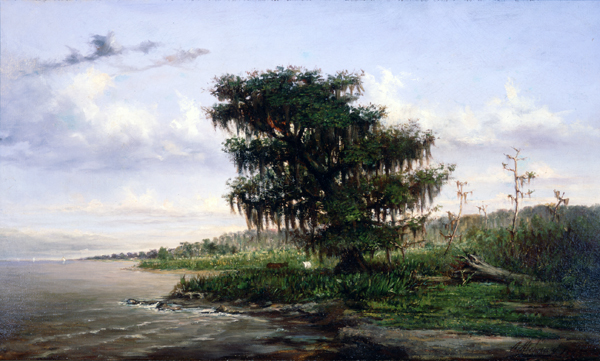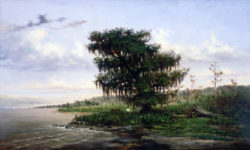Andres Molinary
Born in Gibraltar, Andres Molinary settled in New Orleans in 1872 and became an active leader and teacher in the art community.

Courtesy of Louisiana State Museum
View of Lake Pontchartrain. Molinary, Andres (Artist)
Although he painted landscapes and genre scenes and was a skillful restorer of paintings, it was Andres Molinary’s talent for portraiture that brought him public notice throughout the South. Born in the British territory of Gibraltar on November 2, 1847, Andres Molinary arrived in New Orleans in 1872, where he joined his uncle, John Brunasso, a partner in the importing firm of Fatjo and Brunasso. By then Molinary had studied in Rome, Italy, at the Accademia di San Luca, in Spain at the Academia de Bellas Artes of Seville, as well as in eastern Africa and Morocco. Despite his family’s hopes of Molinary becoming a civil engineer, after additional travels in Mexico and Central America, he settled permanently in New Orleans in 1876. With the help of his uncle, Molinary set up a studio where he began painting portraits of prominent individuals and families. At times he also worked as a teacher and photographer.
Molinary’s works were exhibited throughout New Orleans. They were shown at Wagener’s in 1889, 1883, and 1885, at the Southern Art Union in 1881, at the World’s Industrial and Cotton Centennial Exposition from 1884 to 1885, and repeatedly at the Artists’ Association of New Orleans. In 1915 the Delgado Museum of Art (now the New Orleans Museum of Art) sponsored a retrospective exhibition of his portraits.
Molinary was an active participant in New Orleans’s artistic community. Not only did he make his studio a popular gathering place for local artists, he also helped to found several organizations, including the Southern Art Union, the Artists’ Association of New Orleans (for which he served as vice-president in 1886 and president in 1890), and the Cup and Saucer Club. In 1904-1905, he was a member of the executive committee of the Art Association of New Orleans.
Shortly before his death on September 11, 1915, Molinary married Marie Seebold, an artist who had earlier been his protégé.
